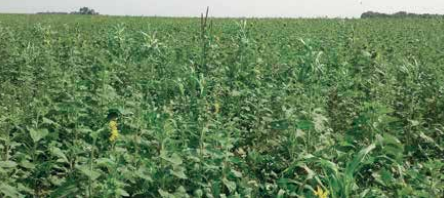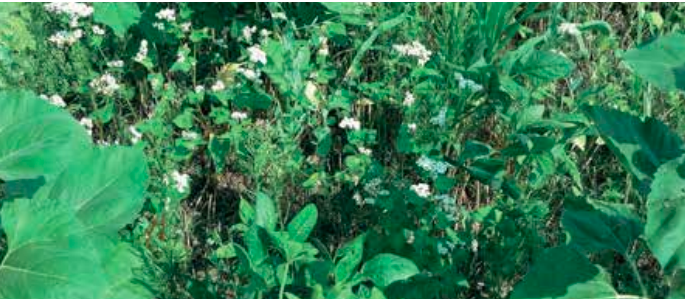By Mark Parker posted on June 1, 2013 | Posted in No-Till Farmer USA
Growing double-crop sunflowers with multiple species has reduced inputs and enhanced primary crop health for Kansas no-tillers Robin and Kelly Griffeth. Double crop sunflowers planted with companion crops have a triple payoff for Jewell, Kan., no-tillers Robin and Kelly Griffeth.
With 2 years of companion cropping under their belts, the Griffeths are harvesting a more profitable sunflower crop, improving their soil and benefitting the subsequent crop in the rotation. The north-central Kansas farmers follow their hard red winter wheat crop with sunflowers intermixed with as many as nine different companion species, each selected for specific attributes. Continuous no-tillers since 1995, Robin and his son, Kelly, operate 3,700 acres as they raise corn, soybeans, wheat, grain sorghum and sunflowers. They were already believers in cover crops when an unplanned “experiment” revealed companion-crop potential.

“It was a fluke, really,” Robin says. “I was planting a field of buckwheat in July 2011. I had about 4 acres left and not enough seed to finish. I hate blank spots, so I mixed up some leftover sunflower seed, winter peas, five different clovers, canola, chickling vetch, safflower and a couple of different radishes — just to bulk up the volume enough to finish.” To their surprise, the sunflowers in the companion mix yielded well, without insecticide, herbicide or additional fertilizer. “We learned a lot by watching that 4-acre patch and decided this was something we needed to research a little further,” he says.
Designer Seed Mix
Kelly came up with a companion mix for the following year — common vetch, chickling vetch, spring forage peas, winter peas, cowpeas, crimson clover, oilseed radishes, purple-top turnips, buckwheat and sunflowers. At their normal rate of 21,600 seeds per acre, sunflowers made up only about 10% of the mix. Buckwheat had the largest number of seeds per acre at 64,800, with the other species ranging from 12,500 to 17,000 — for a total of 206,924 seeds per acre. The sunflower companion mix is planted as soon as possible after harvest, generally late June to early July.
The Griffeths had been planting double-crop sunflowers in 15-inch rows to achieve a quicker canopy. That meant planting at higher populations that depressed yield. What they wanted was a quicker canopy at normal seeding rates. Using their White 6531 31-row planter — which has Keeton seed firmers and Thompson closing wheels, and is set to 15-inch spacings — they planted sunflowers in 30-inch rows with the companion mix planted in the centers as a row filler, nitrogen producer and beneficial-insect attractant.
A Great Plains CTA-4000HD drill has also been used to plant the sunflowers and companion mix in 7½-inch rows, and the Griffeths continue to experiment. In the past 2 years, they’ve planted nearly 1,000 acres of double-crop sunflowers and companion species with the planter and, last year, drilled 54 acres. “You have more control with the planter, but we’re asking ourselves if we really need a picket-row stand,” Kelly says. “As long as we get the desired number of sunflower plants, and they’re fairly well dispersed, it seems to work fine — it’s more like mimicking Mother Nature.” Seeds are planted 1½ inches deep, the optimum depth for sunflowers. This year, Robin and Kelly are going to mix all of the seed together — including the sunflowers — in the planter boxes. They don’t expect a perfect stand, but believe using a soybean planter plate and optimum air pressure will produce good results.
Controlling Weeds
A burndown herbicide is applied after wheat harvest, and 4 to 5 weeks after emergence, the Griffeths spray Select to control volunteer wheat. “The companion crop does an excellent job of controlling weeds, and we may get to a point we don’t use any herbicide. But this is wheat country, so we have to control volunteer wheat,” Robin says. “We may add pearl millet because it will jump up quickly and out-compete weeds, then it’s killed by the Select, allowing other species to take over.” Regarding moisture competition in a 25-inch annual-rainfall environment, Robin points out that sunflower roots extend much deeper into the soil than roots of the companion species.
At harvest, the Griffeths use Lucke Manufacturing sunflower pans mounted on a rigid Case IH head, a system that has worked well. “Most of the taller plants are warm season and have been killed by frost by the time we harvest the sunflowers,” Robin says. “If a species is going to cause a harvest problem, it should be left out. The beauty of the flowers we plant is they get 6 or 7 feet tall. “I wouldn’t recommend this with a dwarf sunflower. You have to choose varieties and companion species wisely.”
Reduced Inputs
For the Griffeths, companion planting eliminates the need for an insecticide and a broadleaf herbicide — as well as an 80-pound-per-acre nitrogen application. Prior to companion cropping, a pesticide was used to control head moths. Now, the companion mix attracts beneficial insects — bees, predator wasps and lady beetles — that have successfully replaced the pesticide. At a cost of $15 to $20 per acre each for the insecticide and herbicide applications, Kelly says the companion-crop seed mix is basically paid for. The entire seed mix, including sunflower seed, costs $65 per acre — about the same cost as doublecrop soybean seed.
The primary profit impact of this comes at harvest time, Robin says. “Yields are comparable to sunflowers without a companion crop — they’re certainly not less,” he says. “The real profit advantage is grain quality. The sunflowers have better plant health, with far less insect damage and that gives us better oil content. “We’re paid a premium for high oil content, and with the companion crops, the oil premium has been the highest we’ve ever received.” Rental Income In addition to higher yields for grain sorghum and corn following sunflowers, the Griffeths may add to double-crop income by renting companion-cropped fields for winter grazing.
Kelly has taken the lead on identifying plants that contribute positively to the mix. “You have to do your homework to find out what companion species will work together,” he says. “If you look on the Internet, you’ll find most of the information comes from gardening Web sites. “You can find out which species grow together, and those that have a negative impact on each other. It’s important to avoid antagonistic combinations. You don’t just throw a random mix out there.” The Griffeths have grown doublecrop, food-grade buckwheat and believe it’s an important component. Kelly says buckwheat makes phosphorus more available for the following crop, establishes quickly and attracts beneficial insects.
Companion Criteria
There is a wide world of other species from which to choose, Kelly points out. “All species have to satisfy two criteria,” he says. “They have to be compatible with the primary crop, not detrimental. “And they have to help us accomplish something we’re after — quick weed suppression, soil building, nutrient cycling and attracting beneficial insects.” Although they continue to assess species and mixes, Kelly says one thing is clear. “I’m not sure you can get too much intensity,” he says. “If there’s been an issue, it’s because the mix is not intense enough. We had some marestail pop up here and there, for example, and we felt it was due to the companion stand not being intense enough.”
Crop Insurance
Robin and Kelly plan to extend their companion-crop concept to corn this year. It will have to be on double-crop corn, however, since crop insurance will not cover the practice. “Making a profit is our primary purpose,” Robin says. “We take care of cash crops first, and anything we try has to pencil out. We’d love to try companion crops on full-season crops but, from a risk management standpoint, you don’t want to make an insurable crop uninsurable.” The Griffeths will plant corn in 30-inch rows with a companion mix of lupins, cowpeas and sunn hemp.
Soil Benefits The Griffeths also plant cover crops ahead of soybeans — typically cereal rye, oats, safflower and mustard, or other mixes. Continuous no-till with cover crops makes a positive soil quality impact, says Kelly. In addition to decreased compaction, reduced erosion and increased water efficiency, the Griffeths have measured rising soil organic-matter content. “We soil sampled a CRP field we’ve farmed for 3 years,” Kelly says. “Organic matter was 3.1% when we took it over and, 3 years later, it was up to 3.5%. That’s all from using cover crops and notill, and I think the companion cropping can have an even bigger impact.
